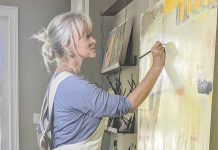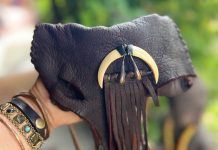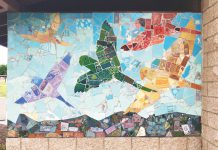The Craft of Collecting
Two gallery owners share their secrets for making an aficionado out of an art neophyte. –By Hannah Ostrow
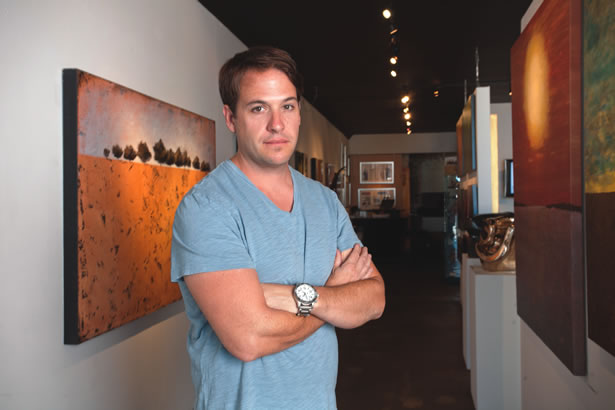
Shane Townley
Owner, Townley Gallery
I would advise doing research on the galleries, directors and artists you’re interested in. A lot of research can be done online, and it’s also a good idea to visit some of the gallery receptions. Like any business, meeting the director or artist in person is the best way to develop a relationship.
I cannot express this enough: The Internet is the latest trend as far as marketing. Every business I can think of is now on Facebook; major corporations to small businesses are taking advantage of this marketing opportunity. Galleries, although still a little weary of the Internet, are slowly starting to join social media. Becoming friends with galleries through social media will be a great way to keep up on current events.
First and foremost, select pieces that you will be able to live with for the rest of your life. Although art is a great investment, it should not be the primary focus for acquiring art. On the other hand, you never know; you could be acquiring the next Jackson Pollock or Picasso. This is the beautiful thing about purchasing original artwork: It’s one of a kind, and no one else in the world will own the same piece. And who knows? The artist could be a million-dollar selling artist someday.
Paul Jillson
Owner, Pacific Edge Gallery
Collecting art can be a lifetime pursuit that enriches your home and your soul. My advice to beginning collectors is to look at everything you can: in galleries, museums and juried artist fairs like the Festival of Arts in Laguna Beach. Look at enough art and you will start to learn your own taste and preferences, and see where that leads you.
Almost every style or movement is represented in a museum or art book, so it is a good idea to see what the experts think are the best examples of the type of art that interests you to guide you in looking for art to collect. Once you connect with a style or a particular medium you can develop a relationship with the galleries that carry works that speak to you. Attending openings and stopping by the gallery to see what is new will make you a familiar face that the gallery staff will pay attention to when you are ready to purchase. I appreciate visitors who really look at the art we have on display and compliment the pieces they respond to, even if they are not in the market to buy anything at that time.
Ultimately, you will be the one living with the artwork, and if chosen well, you will be looking at it for a long time, so your collection should be art that creates an emotional response in you when you see it and has the elements that you have determined are important to you, regardless of what is trendy at the moment.
In my experience, the clients who end up with the most valuable collections are those that follow their passions rather than worrying about what is popular or potentially a good investment. You may change your home decor, or even your home, but great art will always find its place.
Summer of ’64
Curator Grace Kook-Anderson is working to uncover a long-forgotten moment in the timeline of modern art history: UC Irvine’s artistic heyday. -By Hannah Ostrow
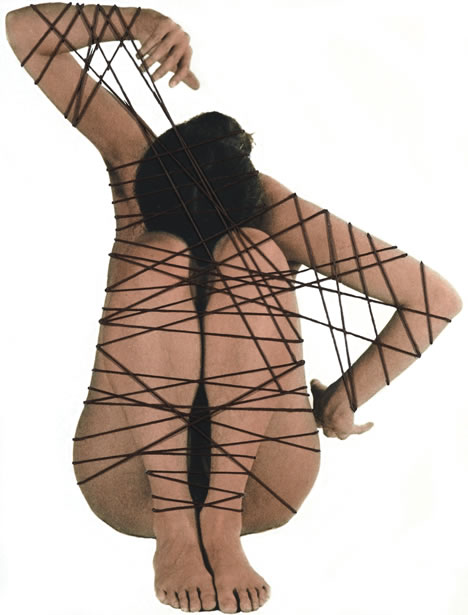
When you think of Irvine, “groundbreaking art community” probably isn’t the first phrase that comes to mind. But long before Diamond Jamboree opened its doors or the Great Park Balloon first took flight, back in the earliest days of UC Irvine, students and faculty at the university put Irvine on the map for their artistic innovations.
“Students at the time were working in video and film—and performance art before there was even a name for it,” says Grace Kook-Anderson, who is curating “Best Kept Secret: UCI and the Development of Contemporary Art in Southern California, 1964-1971” at the Laguna Art Museum.
In 1964, the nascent university administration appointed John Coplans head of the school’s art gallery. An influential British photographer who would become editor-in-chief of Artforum magazine less than a decade later, John recruited numerous working artists to come teach at UCI—including Tony DeLap, Ed Bereal and, briefly, David Hockney. What John constructed was an open-minded and forward-thinking faculty that was responsive to what students were interested in exploring. Irvine became a vibrant hub of artistic growth against a desolate backdrop.
“In Irvine at the time, there was nothing,” Grace says. “But no one was affected by how barren the landscape was—rather, they were inspired by how open it was.”
During the ’60s, Irvine’s role in California’s art scene didn’t fly under the radar as it does today: “It’s a best kept secret today [because] none of that activity has been sustained in Orange County,” Grace says. “Artists went to Venice Beach, New York.”
“Best Kept Secret” will bring the spotlight back onto Orange County and all the creativity that came out of it during the 1960s. The exhibition, which opens Oct. 30 and runs through January, will feature 39 artists who were both faculty members and students between 1964 and 1971. In putting together the exhibition, Grace worked with nearly all of the artists being featured—some of who are still working, locally or elsewhere, and some of whom have moved on to other professions, leaving Grace to bring them along on her journey into the ephemeral.
“I’ve been relying on a lot of oral history,” Grace says, and notes that in her interviews she has received many conflicting stories. “It’s a lot of figuring out what was myth and what was real.”
The exhibit will run in association with “Pacific Standard Time,” a Getty Institute project that explores Southern Californian art history from 1945 to 1980. The project will incorporate 60 institutions from the Bay Area all the way down to San Diego.
Art Marketing for the 21st Century
LagunaART.com has the latest on Laguna Beach’s museum, festivals and galleries—all in one easy-to-use virtual space. By Hannah Ostrow
For a town like Laguna, being an art hub has its obvious benefits—culture and tourism chief among them. It can also mean that for many, the Laguna art scene may seem too big to conquer. Enter LagunaART.com: the one-stop shop for mastering the capacious art world of Laguna Beach.
Launched in 2010, LagunaART.com functions as a virtual gallery for the 180 artists who are members of the Laguna Art Group. Once they find a piece they are interested in, they are directed to the artist’s personal site or to the site of the gallery where this artist exhibits. In the last six months, the site has had about a quarter-million page views.
LagunaART.com also offers a free, user-friendly iPhone app featuring a comprehensive map of Laguna’s galleries, museum and festivals, paired with up-to-date information on offerings and exhibitions.
“It’s about helping the entire art community,” says Bill Bradfield, sales and marketing director for LagunaART.com. The site drives traffic to galleries’ individual sites, as well as foot traffic to physical galleries around town. For artists already associated with a gallery in Laguna, LagunaART.com functions as a supplemental marketing tool.
The site also serves artists who have yet to find a gallery to call home. “There are way more artists than there is wall space in Laguna,” Shane Townley, president of LagunaART.com, says. “And artists don’t know how to market their own websites.” With LagunaART.com, a monthly $49 dollar membership fee affords artists advertising and marketing perks.
Hoping for continued growth both in membership and in website hits, Shane sees LagunaART.com as the shiny, interactive future of the art world. “The Internet has taken over every other media,” he says, forecasting an imminent extinction of physical gallery spaces and the rise of art online. “Where is art going to be?”
Gallery Events
De Ru’s Fine Arts
“Scenes of Laguna Beach as Painted by Early California Impressionists (1890-1940)” will be on display throughout September, including the work of William Wendt, Edgar Payne, Frank Cuprien and Anna Hills. (1590 S. Coast Hwy.; 949-376-3785; derusfinearts.com)
Joanne Artman Gallery
On display through September, “The Back Room” exhibit includes some of the finest works by Peregrine Heathcote, Valerio D’Ospina, Anja Van Herle and America Martin. (326 N. Coast Hwy.; 949-510-5481; joanneartmangallery.com)
Sandstone Gallery
Contemporary artist Jennifer Griffiths’ work will be displayed throughout the month of October, alongside the “Beneath the Surface” exhibit with Anne Moore’s creative printmaking work. (384-A N. Coast Hwy.; 949-497-6775; sandstonegallery.com)
Signature Gallery
With a collection that includes Charles Pabst, Sue Averell, Jenny Simon, as well as numerous others, Signature Gallery presents a wide variety of permanent works that transcend both local and global topics. (220 Forest Ave.; 949-376-4244; thesignaturegallerylaguna.com)
Studio Arts Gallery
Michael Hermann, Gina Lunn and Sian Poeschl all are showcasing their various works with glass during the months of September and October at Studio Arts. Michael and Gina’s works are the result of years of studying the Italian masters and their work with glass, while Sian’s “Landscapes” are unique kiln-formed glass pieces that portray the beauty of Yosemite and Snowdonia, Wales. (1200 S. Coast Hwy.; 949-376-1619;
studioartslaguna.com)
Townley Gallery
With the works of Eren Alptekin, Robert Dunahay, Aurora Aguirre, Scott Swezy and many others on permanent display, Townley Gallery features a plethora of different artistic creations by some of today’s breakthrough artists. (570 S. Coast Hwy.; 949-715-1860; townleygallery.com) LBM


